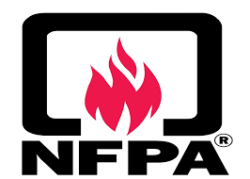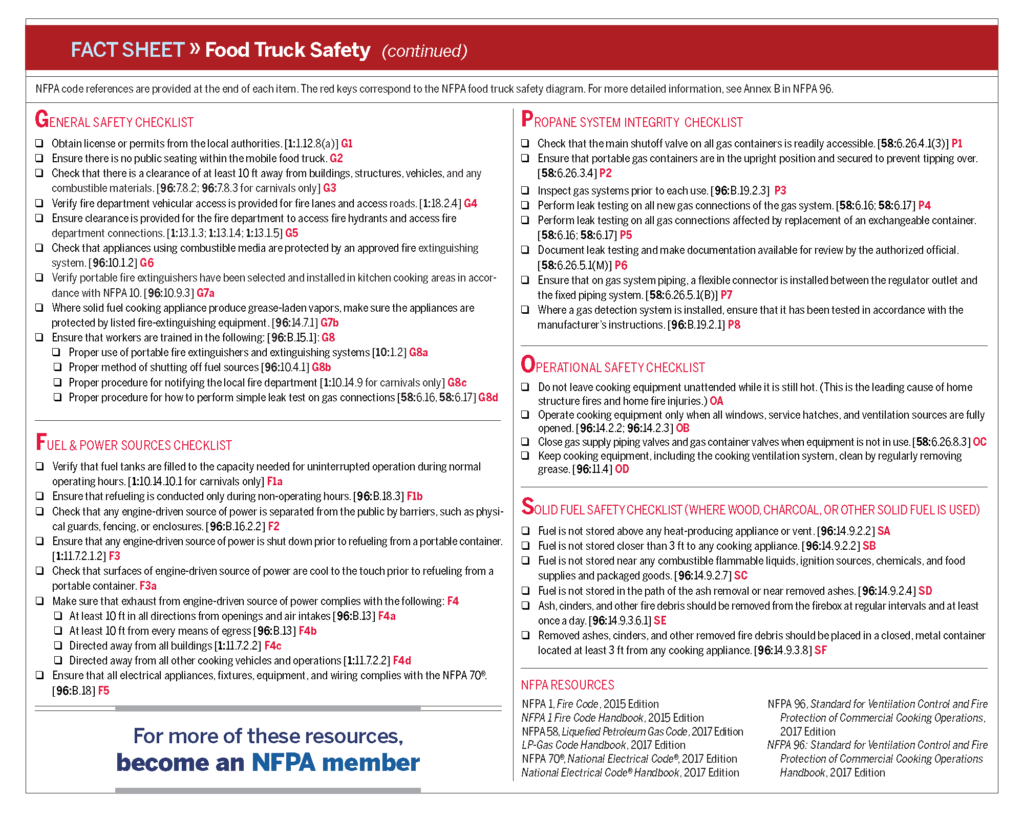Serving safe high quality and delicious food to customers is always be a top priority for food trucks. But in addition to providing safe food, mobile food vendors must also ensure the safety of themselves and customers by using propane in a safe way.

Propane tanks are convenient and economical, which make them the preferred fuel source of food trucks. Even though they are considered stable and safe, propane tanks still possess a certain degree of danger, just like any type of fuel.
Common food vendor fire hazards include tanks out of qualification; overfilled cylinders; unsecured cylinders; propane cylinders inside the truck; aged or worn propane lines and unsecure connections; hot fryer oil and grills too close to tanks; burner knobs left in open position; and gas cans for generators stored too closely to tanks and trucks.
But mobile food vendors do not have to fear as there are simple steps that can be followed regarding propane tank safety and prevent harm to your business or customers.
- Learn about proper hygiene, cross contamination, cold and hot food safety, foodborne pathogens, and best practices to prevent foodborne illness.
- Food Manager Training & ANSI Certification - $99.00
- Food Handler Training - only $7.00!
- HACCP Training 16hr/4hr/1hr
- Enter Promo "train10off" at Checkout
Pipeline and Hazardous Materials Safety Administration (PHMSA) Propane Safety
The Pipeline and Hazardous Materials Safety Administration (PHMSA) offers an informative webinar to guide food truck operators on propane cylinder safety. Watch video here:
The Pipeline and Hazardous Materials Safety Administration (PHMSA) also offers a few things food truck operators should keep in mind regarding propane tank safety:
- Understand the markings on your propane cylinder. These may include symbols that show what type of tank you have, the original manufacture date, and the re-certification date.
- Know if your tanks need to be re-certified and understand the different kinds of cylinder re-qualification.
- The age of the tank can affect its performance. Ensure that your cylinders are not beyond their certified number of years.
- Be familiar to what propane smells like. Propane tank retailers offer scratch pads that can help your employees know the distinct odor of the fuel in case of leakages.
- Flammable liquids like cleaning agents or gasoline should not be near a gas-burning equipment. Fumes from these can get ignited by the pilot burner.
- Know where the gas lines are located inside your truck so that they do not get damage when moving kitchen appliance. Also, check the condition of connections to see if there are any leaks.
- Never attempt to fix a leak yourself. If you suspect a leak, call your supplier immediately! Any appliance connected to problematic cylinder must not be used until the leak is resolved.
National Fire Protection Codes for Mobile Food Vehicles
 Likewise until recently, there were not any National Fire Protection (NFPA) codes, standards, or guidelines to provide the minimum fire safety requirements for mobile food vehicles.
Likewise until recently, there were not any National Fire Protection (NFPA) codes, standards, or guidelines to provide the minimum fire safety requirements for mobile food vehicles.
After the 2014 Philadelphia food truck explosion killed a mother and daughter, the International Fire Marshals Association (IFMA) developed a task group to address this issue and submitted public input to:
- NFPA 96 – Standard for Ventilation Control and Fire Protection of Commercial Cooking Operations. Provides preventive and operative fire safety requirements intended to reduce the potential fire hazard of both public and private commercial cooking operations.
- NFPA 1 – Fire Code. Advances fire and life safety for the public and first responders as well as property protection by providing a comprehensive, integrated approach to fire code regulation and hazard management. It addresses all the bases with extracts from and references to more than 130 NFPA® codes and standards including such industry benchmarks as NFPA 101, NFPA 54, NFPA 58, NFPA 30, NFPA 13, NFPA 25, and NFPA 72.
NFPA – 2017 Edition
In February, the 2017 edition of NFPA 96 was released. This edition now addresses the minimum fire safety requirements for mobile/temporary cooking in new Annex Chapter B. The purpose of placing the language in a normative annex was to allow for the jurisdictions who do not currently adopt/enforce NFPA 96 to adopt solely this normative annex (without having to adopt the rest of NFPA 96) if that jurisdiction wanted to address mobile/temporary cooking specifically.
NFPA: Food Truck Fire Safety – Fact Sheet (PDF)
Download this fact sheet and print it out. It is intended to help advance the safety of mobile and temporary cooking operations.


NOTE: This information is provided to help advance safety of mobile and temporary cooking operations. It is not intended to be a comprehensive list of requirements for mobile and temporary cooking operations. Check with the local jurisdiction for specific requirements. This safety sheet does not represent the official position of the NFPA or its Technical Committees. The NFPA disclaims liability for any personal injury, property, or other damages of any nature whatsoever resulting from the use of this information. For more information, go to nfpa.org/foodtrucksafety.
Latest update on NFPA 1
NFPA 1 is currently in the revision cycle process for the development of the 2018 edition of the Code. The Second Draft Report is posted and allows the public the opportunity to view the language the Technical Committee developed for Mobile and Temporary Cooking Operations. See Section 50.7. Official language will be ready by the end of the summer in 2017.
Fire Safety Basics: Fire Prevention
- Install an automatic fire-suppression system in the truck. Because 57% of food service business fires involve cooking equipment, most municipalities require this equipment to be installed. These systems automatically dispense chemicals to suppress the flames and also have a manual switch. Activating the system automatically shuts down the fuel or electric supply to nearby cooking equipment. Have your fire-suppression system professionally inspected semiannually. The manufacturer can refer you to an authorized distributor for inspection and maintenance.
- Keep portable fire extinguishers as a backup. Class K extinguishers are designed for kitchen fires involving grease, fats and oils that burn at high temperatures. Class K fire extinguishers are only intended to be used after the activation of a built-in hood suppression system. Keep Class ABC extinguishers elsewhere for all other fires (paper, wood, plastic, electrical, etc.).
- Schedule regular maintenance on electrical equipment, and watch for hazards like frayed cords or wiring, cracked or broken switch plates and combustible items near power sources.
- Have your exhaust system inspected for grease buildup. The NFPA Fire Code calls for quarterly inspections of systems in high-volume operations and semiannual inspections in moderate-volume operations. Monthly inspections are required for exhaust systems serving solid-fuel cooking equipment, like wood- or charcoal-burning ovens.
Fire Safety Basics: Staff Training
Train your food truck staff these fire safety basics:
- Find and use a fire extinguisher appropriately. An acronym you may find helpful is PAST – pull out the pin, aim at the base, make a sweeping motion, (be) ten feet away.
- Clean up the grease. Cleaning exhaust hoods is especially important, since grease buildup can restrict air flow. Be sure to also clean walls and work surfaces; ranges, fryers, broilers, grills and convection ovens; vents and filters.
- Never throw water on a grease fire. Water tossed into grease will cause grease to splatter, spread and likely erupt into a larger fire.
- Remove ashes from wood- and charcoal-burning ovens at least once a day.
- Store flammable liquids properly. Keep them in their original containers or puncture-resistant, tightly sealed containers. Although a food truck kitchen is very small, you should attempt to store containers in well-ventilated areas away from combustible supplies, food, food-preparation areas or any source of flames.
- Tidy up to avoid fire hazards. Store paper products, linens, boxes and food away from heat and cooking sources. Properly dispose of soiled rags, trash, cardboard boxes and wooden pallets at least once a day.
- Use chemical solutions properly. Use chemicals in well-ventilated areas, and never mix chemicals unless directions call for mixing. Immediately clean up chemical spills.
Prepare An Emergency Plan
If a fire breaks out in your food truck, your staff must take control of the situation and all employees must safely exit the vehicle and lead customers to a point safely away from the truck.
- Be prepared to power down. Train at least one worker per shift how to shut off propane and electrical power in case of emergency.
- Have an evacuation plan. Designate one staff member per shift to be evacuation manager. That person should be in charge of calling 911, determining when an evacuation is necessary and ensuring that everyone exits the food truck safely. Ensure your staff knows where all of the exits are.
- Offer emergency training. Teach new employees about evacuation procedures and the usage of fire-safety equipment. Give veteran staff members a refresher course at least annually.
Food Truck – Fire Safety Additional information
- NFPA podcast on mobile food trucks
NFPA Journal’s Jesse Roman speaks to Jacqueline Wilmot, NFPA’s Staff Liaison for NFPA 96 - NFPA Journal article – “All Up in Our Grill”
by Jesse Roman, May/June 2015 - Presentation from NFPA’s 2015 Conference & Expo – Mobile Food Truck Regulation: Developing a Recipe for Success
Ronald Farr, Lead Regulatory Engineer, UL; R.T. Leicht, Chief Protection Specialist, State of Delaware; and Jacqueline Wilmot, NFPA Fire Protection Engineer
- WTCM radio interview in Traverse City, MI – Discussion of food trucks, and the standards of safety NFPA is working to create around these mobile eateries
Meredith Hawes, NFPA Public Education Regional Specialist, Jacqueline Wilmot, NFPA Fire Protection Engineer; and Chief Jim Tuller, Traverse City Fire Department
- City of Chicago fire safety permit consultant packet for mobile food vehicles (PDF, 459 KB)
- Food truck operation awareness flyer (PDF, 439 KB) – U.S. Department of Transportation
- Requalification Guidance for Propane Cylinders (PDF, 316 KB) – U.S. Department of Transportation
